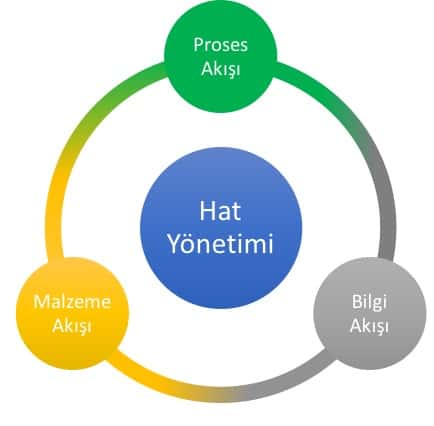Having covered the history of assembly line management and line balancing in the last article, in this article we will discuss the 3 key principles of effective line management and continuous flow in a production and/or assembly line. These are;
- Process Flow
- Material Flow
- Information Flow
are gathered under 3 main headings.
In assembly lines, typically, only line balancing is done to improve the process flow. Process flow is one of the 3 key elements enhancing the effectiveness of line management; however, it is not possible to talk about a healthy and effective line management without the other 2 key elements. Now let’s examine the 3 pillars in detail.

Process (Production) Flow
To ensure a healthy flow in the assembly line, firstly, the capacities and production speeds of processes need to be examined both according to customer demand and internally.
You can analyze whether your process flow is sufficient by asking yourself the following questions:
- Are there high levels of inventory between processes? Are materials waiting for operators or machines?
- Are finished product inventories at high levels? Are your shipping depots overflowing with idle products?
- Can you measure the performance and availability levels of your production lines accurately?
- Does your production have a rhythm? Or are you constantly struggling with overtime?
According to the Just In Time principle, producing in harmony with customer demand means that the Cycle Time of a line is the same as the Takt Time (Customer Demand Rate). If the cycle time is shorter than the takt time, early-excess production waste is encountered. On the contrary, if a line produces later than the takt time, there is a risk of not meeting the orders.
Therefore, it is necessary to calculate the takt time correctly. Not only the takt time but also considering the capacity situation, it is necessary to take into account how much capacity is occupied by other product groups that must be produced additionally on the line. Otherwise, even if the takt time calculation is correct, it will not be realistic due to the neglect of capacity.
As much as the harmony of the production line with the customer pace, it is necessary to consider the harmony between the processes or stations within the production line. In processes or stations with different capacities, even though the capacities are different, if they are not balanced in terms of production speeds, continuous flow cannot be ensured in production. In lines where production is carried out without continuous flow, semi-finished stocks (Work In Process – WIP) are observed between processes.
In assembly lines, the total workload times of the stations are expected to be equal to or less than the cycle time. Since all stations operate simultaneously in the assembly line, the capacity is commonly shared for the same product group. Therefore, if the capacity of the assembly line is calculated, there is no need to calculate the capacities of individual stations separately. The speed of an assembly line is equal to the speed of the slowest station, the “bottleneck station“.
However, this situation is not valid for production lines outside the assembly line. Each process, shared by different products in terms of capacity, may produce at different times. In this case, continuous flow cannot be mentioned; however, in order to accelerate the process flow, even though not as much as in the assembly line, correct production control methods (FIFO, CONWIP, Kanban, Sequential Pull) need to be applied to manage inter-process stocks and reduce batch sizes.
Material Flow
Process flow may be perfectly designed, yet if a production or assembly line lacks raw materials or semi-finished products, it is impossible to talk about flow in that line. Even if a Formula-1 car delivers flawless track performance (production), if it waits excessively for tire or fuel replenishment (material flow) during a pit stop, it will lose the race. Because Formula-1 races are won both on the track and in the pit.
Is the easiest way to achieve flawless material flow to create a continuous line with all semi-finished and raw materials piled up next to it without stopping? If you have unlimited space, money, and patience to deal with potential quality defects, this method may seem practical, but it is not economical at all.
You can analyze whether your material flow is sufficient by asking yourself the following questions:
- Are production or operators stopping the line due to material waiting?
- Do your material transport operations have a standard, or do transport elements supply materials only according to the requested order and quantity like a grocery apprentice?
- Do you have waiting stops for crates? Are operators losing time due to transfer and handling losses?
- Can the required material be found immediately in the warehouse? How is your 5S level?
Effective line management requires materials to be produced in the right batch sizes, crated in the right quantities and transferred to the relevant locations with the right routes and at the right frequencies. For this, it is inevitable to define standards very clearly, not only for production control but also for material flow control. Milkrun systems can only be managed with a healthy material flow setup. The importance of the 5S topic will be even more felt when providing material flow.
To produce in the correct quantities, capacities need to be examined and correct production control methods need to be used, as we mentioned in the process flow section.
It is also necessary to correctly design the material crate methods from supplier process to customer process or assembly line. Aligning the batch size produced by the supplier process with the consumption rate of the customer process is as critical as stacking the material in the right crates and standard quantities. All basic information, such as determining the quantities inside the crates with a plan approach (PFEP), and standardizing the dimensions of crate types, should be created on a material basis.
Examining the unit that will provide the material flow for a correct route is crucial. The wastes of the transport team should be examined, the sequence of work should be followed, and capacities should be analyzed. A standard route should be established for the transport team, and the stock management policy at the points where the material will be supplied should be determined. (Fixed cycle-variable stock, fixed stock-variable cycle)
Information Flow
If you organize the production flow and design the material flow correctly, but still cannot provide the information flow completely, unfortunately, it is still not possible to run the production flow healthy.
You may have made a flawless production plan, but if you cannot transfer this plan to the production lines correctly or cannot manage the variability in production dynamics, it is possible to say that there is a lack of information flow.
You can analyze whether your information flow is sufficient by asking yourself the following questions:
- Can you instantly access why the production plan is not being followed, or does it take until the end of the day to realize the situation?
- Are you experiencing quality problems due to incorrect information or misunderstanding correct information?
- Is production somehow managing problems and are you constantly renewing your production plan because of this?
- Can you analyze the reasons for line stops, or are your production problems evaporating?
- Are you constantly renewing your production plan and revising the renewed plan repeatedly at the end of the day?
To ensure correct information flow, it is necessary to facilitate access to information in production, establish systems that will control production information flow and create quality while producing (kanban boards, supermarket visualization, andon, poka yoke systems, etc.), create a production culture that will reveal problems, and take preventive actions to eliminate problems permanently through daily management meetings.
Otherwise, with a production environment where you can do nothing but constantly revise production plans due to the inadequacy of information flow, you will face quality defects that may arise from inadequate information flow and the reignition of extinguished fires.

